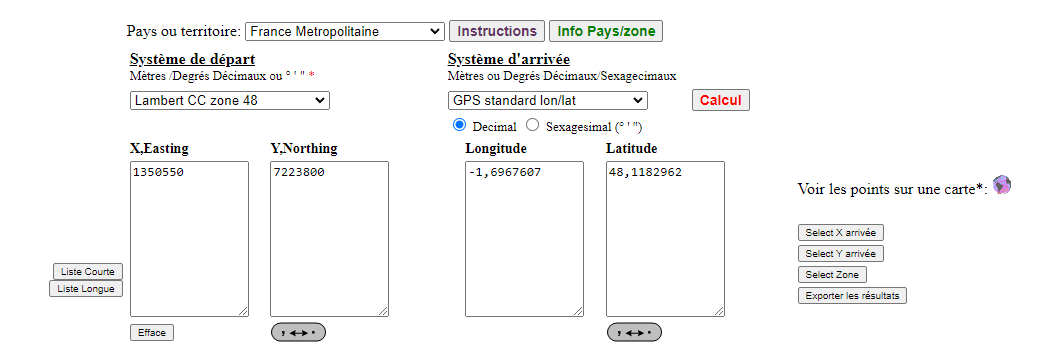Ok, first of all thank you Jean-Marc for your help.
So I use your last link to do that :
# -*- coding: utf-8 -*-
import Autodesk
from Autodesk.Revit.DB import *
import Autodesk.Revit.DB as DB
import webbrowser
import math
def utmToLatLng(zone, easting, northing, northernHemisphere=True):
if not northernHemisphere:
northing = 10000000 - northing
a = 6378137
e = 0.081819191
e1sq = 0.006739497
k0 = 0.9996
arc = northing / k0
mu = arc / (a * (1 - math.pow(e, 2) / 4.0 - 3 * math.pow(e, 4) / 64.0 - 5 * math.pow(e, 6) / 256.0))
ei = (1 - math.pow((1 - e * e), (1 / 2.0))) / (1 + math.pow((1 - e * e), (1 / 2.0)))
ca = 3 * ei / 2 - 27 * math.pow(ei, 3) / 32.0
cb = 21 * math.pow(ei, 2) / 16 - 55 * math.pow(ei, 4) / 32
cc = 151 * math.pow(ei, 3) / 96
cd = 1097 * math.pow(ei, 4) / 512
phi1 = mu + ca * math.sin(2 * mu) + cb * math.sin(4 * mu) + cc * math.sin(6 * mu) + cd * math.sin(8 * mu)
n0 = a / math.pow((1 - math.pow((e * math.sin(phi1)), 2)), (1 / 2.0))
r0 = a * (1 - e * e) / math.pow((1 - math.pow((e * math.sin(phi1)), 2)), (3 / 2.0))
fact1 = n0 * math.tan(phi1) / r0
_a1 = 500000 - easting
dd0 = _a1 / (n0 * k0)
fact2 = dd0 * dd0 / 2
t0 = math.pow(math.tan(phi1), 2)
Q0 = e1sq * math.pow(math.cos(phi1), 2)
fact3 = (5 + 3 * t0 + 10 * Q0 - 4 * Q0 * Q0 - 9 * e1sq) * math.pow(dd0, 4) / 24
fact4 = (61 + 90 * t0 + 298 * Q0 + 45 * t0 * t0 - 252 * e1sq - 3 * Q0 * Q0) * math.pow(dd0, 6) / 720
lof1 = _a1 / (n0 * k0)
lof2 = (1 + 2 * t0 + Q0) * math.pow(dd0, 3) / 6.0
lof3 = (5 - 2 * Q0 + 28 * t0 - 3 * math.pow(Q0, 2) + 8 * e1sq + 24 * math.pow(t0, 2)) * math.pow(dd0, 5) / 120
_a2 = (lof1 - lof2 + lof3) / math.cos(phi1)
_a3 = _a2 * 180 / math.pi
latitude = 180 * (phi1 - fact1 * (fact2 + fact3 + fact4)) / math.pi
if not northernHemisphere:
latitude = -latitude
longitude = ((zone > 0) and (6 * zone - 183.0) or 3.0) - _a3
return (latitude, longitude)
doc = __revit__.ActiveUIDocument.Document
basepoint = FilteredElementCollector(doc).OfCategory(BuiltInCategory.OST_SharedBasePoint).ToElements()
for b in basepoint:
if b.IsShared:
projectSurvpntEW = b.get_Parameter(BuiltInParameter.BASEPOINT_EASTWEST_PARAM).AsDouble()
projectSurvpntNS = b.get_Parameter(BuiltInParameter.BASEPOINT_NORTHSOUTH_PARAM).AsDouble()
projectlat = b.get_Parameter(BuiltInParameter.BASEPOINT_LATITUDE_PARAM).AsDouble()
projectlong = b.get_Parameter(BuiltInParameter.BASEPOINT_LONGITUDE_PARAM).AsDouble()
# projectSurvpntZ = b.get_Parameter(BuiltInParameter.BASEPOINT_ELEVATION_PARAM).AsDouble()
print(projectSurvpntNS,projectSurvpntEW)
print(projectlat,projectlong)
latlong = utmToLatLng(32,projectSurvpntNS,projectSurvpntEW)
print (latlong)
url = "https://earth.google.com/web/@" + str(latlong[0]) + "," + str(latlong[1]) + ",100000d"
webbrowser.open(url)
But
- I don’t know if I have to use for the conversion
projectSurvpntEW = b.get_Parameter(BuiltInParameter.BASEPOINT_EASTWEST_PARAM).AsDouble()
projectSurvpntNS = b.get_Parameter(BuiltInParameter.BASEPOINT_NORTHSOUTH_PARAM).AsDouble()
or
projectlat = b.get_Parameter(BuiltInParameter.BASEPOINT_LATITUDE_PARAM).AsDouble()
projectlong = b.get_Parameter(BuiltInParameter.BASEPOINT_LONGITUDE_PARAM).AsDouble()
- I think that the conversion is maybe not the good one for what I’m trying to do…
With the values that are coming from LATITUDE and LONGITUDE, using an online converter, I can successfully find the project location
Using Latitude and Longitude from this converter, I can find the project with a combined url
Now, I need to make something more common for all the projects (if it’s possible … )

